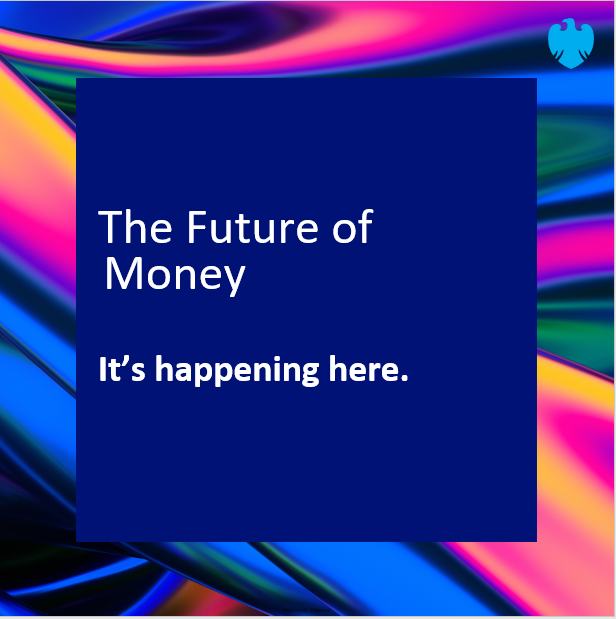What is money? What is it for? Who can create it? Who can own it? Can you choose to use it anyway you like? As technology disruption changes the face of banking and payments across the globe, these are the questions facing every currency-issuing country in the world.
At Barclays, our technology people are working with our policy and treasury people, as well as central banks and governments, to help define the answers. Just ask Lee Braine and his team. Lee is a Managing Director in Barclays’ Chief Technology Office. He is also one of Barclays’ five Distinguished Engineers – thought-leaders who drive and champion the excellence of our technology teams internally and externally.
Lee and his team are focused on investigating the viability and suitability of advanced technologies for the bank. That can mean prototyping new industry architectures for post-trade processing, exploring use cases for quantum computing, or finding ways to make digital currencies work for central banks.
Lee is a member of the Bank of England and HM Treasury’s Central Bank Digital Currency (CBDC) Technology Forum, exploring the digital future of the pound sterling. “Last year, the former UK Chancellor, and now UK Prime Minister, Rishi Sunak set out a potential roadmap for development of a UK CBDC and, earlier this year, US President Joe Biden signed an executive order placing urgency on analysing options for a potential US CBDC,” says Lee.
“Cryptocurrencies started as a libertarian idea, with an aim of allowing anyone to transfer value without censorship and without the need for trusted institutions such as banks and central banks. What’s exciting is that this original idea has evolved and transformed during the last decade, with over a hundred central banks across the globe now exploring the potential of issuing their own digital currencies,” explains Lee.
It’s some of the most interesting and challenging work we do. It includes us in conversations that have the potential to change the world.
Nineteen of the G20 countries are currently exploring a CBDC, with sixteen already in development or being piloted. The Bank of England, the European Central Bank and the US Federal Reserve Bank are trying to work out the way forward and are working closely with the private sector. And while the inspiration and technology behind CBDCs can potentially be similar to some cryptocurrencies, they are actually very different.
To date, cryptocurrencies are typically privately issued, decentralised and unregulated, although many jurisdictions are exploring how to regulate them in future. Their value can be dependent on how many users and investors want to hold and use a particular crypto coin. The aim for a UK CBDC would be to deliver a digital currency that’s as stable and reliable as the pound in any other form. £10 of a UK digital currency would always be worth the same as a £10 note.
Today, there are essentially two types of pound sterling you can use when you pay for something. There’s physical cash. And there’s money held by your bank in the form of a deposit. Both types of money are worth the same. And you can convert your deposits into cash by, for example, withdrawing notes from a cash machine.
However, the use of cash is declining. Debit cards overtook cash as the main form of payment in the UK back in 2017. A CBDC is a new kind of money without physical form, that is issued by a central bank, such as the Bank of England, and is a direct liability of the central bank. Rather than being a physical note or a coin, it exists as data on a computer. In the future, a potential UK CBDC could allow you to convert money in your deposit account into digital pounds, issued by the Bank of England, and pay for things with them.
A UK digital currency could make the payments side of the UK banking system more resilient and competitive. It could also improve the efficiency of cross-border payments, assuming that countries collaborate on CBDC interoperability.
But there are also significant risks to be addressed.
“The topic of CBDC is very complex from policy, financial and technology perspectives. And not just because the solutions are hard. It's that there are so many options available to us.” says Lee.
Designing a CBDC means making many inter-related choices. It's exciting, interesting and impactful
Ultimately, it comes down to the motivations of the central bank and government. For example, central banks that are charged with ensuring the stability of money in the economy may see a CBDC as a way of allowing citizens to convert commercial bank money into central bank money on demand and without loss of value, despite the trends away from physical cash. Additionally, governments that are concerned with ensuring competition and innovation in the development of new functionality using tokenised money may see a CBDC as a way of providing a widely-available digital settlement asset.
“The design of a CBDC as a new form of digital money is taking inspiration from commercial bank money, physical cash and new technology innovations. Which attributes are desirable and which should be amended or discarded? Consider topics such as access, privacy, usability, infrastructure, interoperability, sustainability, monetary policy, etc. The fascinating thing is that those choices are currently being explored. And our work can feed into that by advising on technology aspects ranging from high-level architectures to low-level interface designs.”
One of the key challenges is that adoption of a CBDC could risk fragmentation in both payments markets and retail deposits. For example, there would be fragmentation issues if different types of co-existing digital money had different operational characteristics or were not interoperable.
In March 2022, Lee and Shreepad Shukla, an enterprise architect in Lee’s team, publicly released a paper that set out a potential way of mitigating that fragmentation risk. The paper presents an industry architecture including a common ecosystem across both CBDC and commercial bank deposits. It’s a digital framework that allows banks and other authorised and regulated providers to interface with UK CBDC, placing both forms of money on a similar footing, and mitigating the risk of fragmentation.
The industry architecture builds on the Bank of England’s ‘platform model’, with the Bank of England operating the core ledger that records CBDC value, processing the payment transactions made using a digital pound, and providing access to that core ledger to authorised and regulated Payment Interface Providers (PIPs).
The PIPs, in turn, would provide users with access to their balances and transactions on the core ledger through pseudonymous identities. Access for PIPs would be managed through application programming interfaces (APIs). These could be similar to the Open Banking APIs that already connect up many of our banking and payment systems, linking disparate financial institutions with diverse systems architectures through common technology standards.
The industry architecture also creates the potential for multiple ecosystems providing competing services using different platforms and technologies, but with common policies and standards.
The Bank of England would exercise control and oversight over the core ledger, making sure it is secure, compliant and private. It would make independent decisions on the technology it uses to run the ledger, allowing for resilience, scalability and availability. And shifting all the programming for interoperability to the PIP layer removes complexity from the ledger layer, making the ledger layer simpler and potentially more stable and more secure.
The paper was designed to drive discussion about the potential industry architecture behind a digital pound. Lee’s team subsequently developed a prototype and the industry explored its potential in practice via a hackathon in September 2022.
Ultimately, this is about our talented technology people making an impact. Unlike some innovations, this not something you can do in isolation. The only way to influence is if you have a seat at the table, collaborating across the industry with peer banks, fintechs, central banks and governments
Lee says that means applying an engineering mindset to both deep intellectual challenges and real-world problems. “In order to drive change, you need a strong understanding of the political and economic factors driving the agenda, not just the technology. You have to ask yourself fundamental questions such as ‘What is money?’ and ‘How could the nature of money change throughout the financial industry and across borders and different jurisdictions?’ You have to think bigger and bolder.”
In turn, that means the people in Lee’s team find themselves driving the way, as published experts in fields like CBDC, post-trade processing, blockchain and quantum computing.



